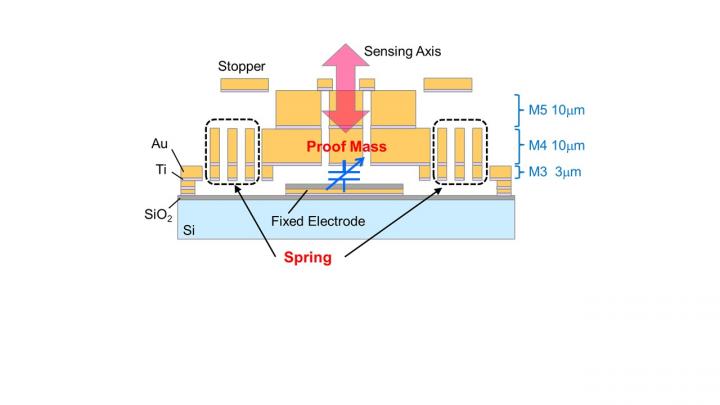Sensitivity over 100 times, noise less than one-tenth

Credit: Sensors and Materials, Daisuke Yamane
A significant increase in the demand of accelerometers is expected as the market for consumer electronics, such as smartphones, and social infrastructure monitoring applications are expanding. Such miniaturized and mass-producible accelerometers are commonly developed by silicon MEMS technology where the fabrication process is well established.
In the design of accelerometers, there is a trade-off between the size reduction and the noise reduction because the mechanical noise dominated by the Brownian noise is inversely proportional to the mass of the moving electrode called as proof mass. Moreover, as for capacitive accelerometers, the sensitivity is generally proportional to the accelerometer size, and thus there is also a trade-off between the size reduction and the sensitivity increase. Since high-resolution accelerometers require low noise and high sensitivity performances, it has been difficult for conventional silicon-based MEMS accelerometers to detect 1 μG level input acceleration.
Low noise and high sensitivity MEMS accelerometer
The research group consisting of Tokyo Tech and NTT Advanced Technology Corporation has previously proposed a method to downscale the proof mass size of MEMS accelerometers to less than one-tenth by using gold material. In this work, as an extension of this achievement, they have employed multi-layer metal structures to the proof mass and spring components, and developed a low noise and high sensitivity MEMS accelerometer.
As shown in Fig. 1, they reduced the Brownian noise being inversely proportional to the proof mass by increasing the mass per area with the use of multiple layers of gold for the proof mass structure.
Furthermore, they utilized the whole area of the 4 mm square chip by reducing the warpage of the proof mass, which enabled them to increase the capacitance sensitivity of the accelerometer. Figure 2 shows a chip photograph and scanning electron microscope images of the developed MEMS accelerometer.
With these results, the developed accelerometer achieved the sensitivity to be one hundred times or more and the noise to be one-tenth or less as compared with conventional accelerometers with the same size, as shown in Fig. 3. Accordingly, they confirmed that the accelerometer would have potential to detect input acceleration to be as low as 1 μG. The fabrication process utilized semiconductor microfabrication process and electroplating, and thus it could be possible to implement the developed MEMS structures on an integrated circuit chip. Therefore, the proposed technology would be useful to increase the resolution of miniaturized accelerometers for general purpose use.
An era of placing a large number of sensors on all thing
It would be a breakthrough in a variety of motion sensing application to realize an ultra-compact and high-resolution accelerometer. Such accelerometer can be applied to medical and healthcare technology, infrastructure monitoring, high precision control of ultra-lightweight robots, mobile vehicle control, navigation system in places where GPS cannot be used and space environment measurement that needs ultra-low acceleration sensing.
In the near future, an era of placing a large number of sensors on all thing is expected to come, and in such case, it would be extremely important to miniaturize high-resolution accelerometers because accelerometer technology is a fundamental of motion sensing.
###
(1) MEMS (Microelectromechanical Systems)
A term that represents micrometer-scaled three-dimensional electronics and mechanical devices manufactured by semiconductor microfabrication process. Currently, the majority of commercialized accelerometers are silicon-based MEMS devices.
Media Contact
Kazuhide Hasegawa
[email protected]
Related Journal Article
http://dx.



